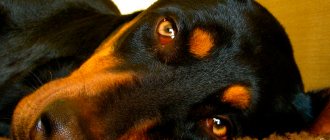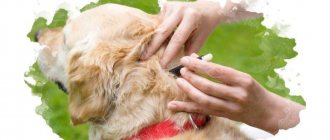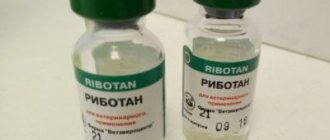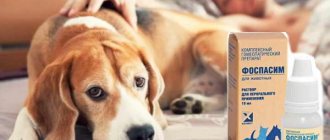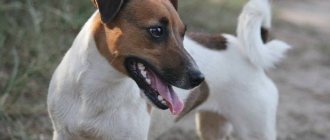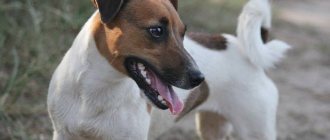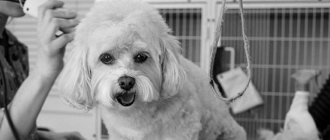Content
1. General description 2. Composition and action 3. Purpose 4. Dosage and application features 5. Limitations 6. Price and analogues 7. Reviews
Perhaps anyone knows that the first remedy for poisoning and diarrhea can be activated carbon. What if your pet is poisoned? Can activated charcoal be useful and, most importantly, safe for dogs? Experts say that this effective and inexpensive drug will help with diarrhea and vomiting caused by poisoning in animals.
What to do if your pet is poisoned
It only takes minutes to help your pet if there is a disorder. Therefore, the first thing to do is detoxify: stop the spread of toxic substances and their accumulation.
Before giving the absorbent, you need to carry out a whole range of procedures, namely:
- Induce a gag reflex by placing a finger deep into the oral cavity, then lightly press on the root of the tongue (you can use a small amount of salt).
- Rinse the dog's stomach: a light solution of potassium permanganate (liter) and forcefully pour it onto the pet. Here you can use a plastic bottle - place the standard neck in the corner of the mouth and pour in the prepared solution to create vomiting.
- Now you can give your dog “black coal” - grind several tablets (depending on weight) in 0.5 glass of water. After this, you cannot induce vomiting. The procedure is repeated several times.
If in an emergency there is no activated carbon in the first aid kit, then chicken eggs will come to the rescue: whites (1-3 pieces) are able to collect and remove toxic substances from the body, but, of course, they are not so effective.
Cleansing enemas made from a weak solution of potassium permanganate will help flush the intestines during diarrhea. If the causes of the disorder and vomiting in a dog have not been established, it is better not to use laxatives.
If your pet is poisoned, it is better to take it to the veterinarian as soon as possible or call a doctor at home. Moreover, it is not recommended to limit treatment to the procedures listed above, despite the improvements.
In an emergency, activated carbon alone is not enough, since 2 ml of the active substance - atropine - must be injected subcutaneously as soon as possible to prevent the absorption of toxic substances, as well as a diuretic drug - Lasix, as shown in the instructions. At the same time, the dog is given a light solution of rehydron: ½ glass per hour.
Composition and action
Activated carbon is a physical and chemical antidote, effectively used in both traditional medicine and veterinary medicine due to its availability and low price.
To become a medicine, charcoal undergoes special preparation. After it, it acquires increased adsorbing capacity. The medicinal properties of the drug lie in the fact that it also binds you:
- salts of heavy metals;
- alkaloids;
- poisonous and narcotic substances;
- toxins released by pathogenic microorganisms;
- harmful chemical compounds, etc.
Important!
The drug is less effective against acids and alkalis (cyanides, etc.).
Activated carbon is a safe medicine; it begins to act quickly and is excreted unchanged from the body in the feces within 8-10 hours.
The sorbing properties of activated carbon can be presented in the form of a table:
Substances that activated carbon binds
Substances that activated carbon does not bind
- paracetamol;
- pyrethrins (pyrethroids);
- salicylates;
- strychnine;
- rodenticide;
- digoxin;
- organophosphates, etc.
- heavy metals (copper, arsenic, iron, lead, lithium);
- alcohols;
- caustic acids, alkalis;
- petroleum products (gasoline, kerosene, etc.);
- mineral acids;
- ethylene glycol;
- table salt;
- xylitol;
- plasticine and other masses for modeling;
- inorganic toxins (ammonia, fluorides, cyanides, nitrates, phosphorus, borates, bromides, chlorates, nitrites, etc.);
- metaldehyde, etc.
Currently, in traditional medicine there is a tendency to reduce the use of activated carbon as an enterosorbent. It has been suggested that the treatment has potential risks, but in veterinary medicine the medicine is used actively, since quick qualified help from a specialist is not always and everywhere available to determine the cause of poisoning and quickly give the dog an antidote.
Important!
Activated carbon should be used for indigestion only if it is known that the pathology was caused by toxic substances entering the body.
Activated carbon instructions for use
Release form
Capsules 0.2 g, 0.25 g.
Tablets: 0.23 g, 0.25 g, 0.32 g, 0.5 g.
pharmachologic effect
Pharmacological action - detoxification, adsorbent, antidiarrheal.
It is characterized by high surface activity, which determines the ability to bind substances that reduce surface energy (without changing their chemical nature).
Sorbs gases, toxins, alkaloids, glycosides, heavy metal salts, salicylates, barbiturates and other compounds, reduces their absorption in the gastrointestinal tract and promotes excretion from the body with feces.
Active as a sorbent during hemoperfusion.
Weakly adsorbs acids and alkalis (including iron salts, cyanides, malathion, methanol, ethylene glycol).
Does not irritate mucous membranes. When applied topically in a patch, it increases the rate of healing of ulcers.
To develop the maximum effect, it is recommended to administer immediately after poisoning or within the first hours. When treating intoxications, it is necessary to create an excess of carbon in the stomach (before gastric lavage) and in the intestines (after gastric lavage).
The presence of food masses in the gastrointestinal tract requires administration in high doses, because the contents of the gastrointestinal tract are sorbed by carbon and its activity decreases. Reducing the concentration of carbon in the medium promotes desorption of the bound substance and its absorption (to prevent resorption of the released substance, repeated gastric lavage and administration of carbon are recommended).
If poisoning is caused by substances involved in the enterohepatic circulation (cardiac glycosides, indomethacin, morphine and other opiates), it is necessary to use charcoal for several days.
It is especially effective as a sorbent for hemoperfusion in cases of acute poisoning with barbiturates, glutethimide, and theophylline.
Pharmacokinetics
Activated carbon is non-toxic and is easily excreted from the body. Activated carbon is not absorbed from the intestines and is completely excreted in the feces after 7-10 hours. The feces after taking the drug are colored black.
Indications
Dyspepsia, diseases accompanied by processes of putrefaction and fermentation in the intestines (including flatulence), increased acidity and hypersecretion of gastric juice, diarrhea, acute poisoning (including alkaloids, glycosides, salts of heavy metals), diseases with toxic syndrome — food toxic infections, dysentery, salmonellosis, burn disease in the stage of toxemia and septicotoxemia, hyperazotemia (chronic renal failure), hyperbilirubinemia (chronic and acute viral hepatitis, cirrhosis of the liver), allergic diseases, bronchial asthma, atopic dermatitis, preparation for x-ray and ultrasound examinations (to reduce gas formation in the intestines).
Dosage regimen
Orally, in the form of an aqueous suspension or in tablets 1-2 hours before or after meals and taking other drugs. The average dose of activated carbon is 100-200 mg/kg/day (in 3 doses). The duration of treatment with activated carbon is 3-14 days; if necessary, a second course is possible after 2 weeks.
For poisoning and intoxication - 20-30 g in the form of an aqueous suspension: the required amount of powder for preparing the suspension is diluted in 100-150 ml of water (1 teaspoon contains 1 g).
In case of acute poisoning, treatment begins with gastric lavage with a 10-20% suspension, then switches to oral administration - 20-30 g / day. Treatment is continued at the rate of 0.5-1 g/kg/day in 3-4 doses for 2-3 days.
For dyspepsia, flatulence - 1-2 g 3-4 times a day. The course of treatment is 3-7 days.
The course of treatment with activated carbon for diseases accompanied by fermentation and putrefaction in the intestines, increased secretion of gastric juice, lasts 1-2 weeks. Adults - 10 g 3 times a day; children under 7 years old - 5 g, 7-14 years old - 7 g per dose.
Purpose
Activated carbon is used as first aid if a pet is suspected of being poisoned:
- low-quality feed or spoiled food;
- salts of heavy metals;
- industrial emissions;
- medicines;
- poisons (for example, zoocoumarin);
- hazardous chemicals.
Important! The instructions for the medicinal product contain instructions that charcoal is effective against flatulence and gas formation in the intestines, but clinical studies have shown that it does not have a noticeable effect on reducing gas formation, it only reduces the smell of gases.
The therapeutic effect of the drug occurs in two stages:
- Adsorption. Once in the gastrointestinal tract, activated carbon “collects” toxic substances.
- Removing toxins from the body naturally - through bowel movements.
In addition, the medicine can be used as part of complex therapy to reduce the level of toxins in the pet’s body:
- for infectious diseases;
- liver pathologies;
- allergic dermatitis, etc.
Important!
The use of activated carbon will be effective if given to the dog in the first hours of poisoning.
Causes of pet distress
If a dog has loose stools, the origin of this disease may lie in the following:
- improper diet or consumption of missing foods;
- a sharp change in the usual menu (transition from dry rations to full meals and vice versa);
- foreign objects entering the intestines that cause imbalance;
- worms and chemical poisoning;
- infectious diseases;
- allergic reactions of the body;
- lack of microelements and vitamins;
- mechanical damage to the gastrointestinal tract organs, improper operation;
- oncology.
If a pet’s disorder is associated with the presence of one of these conditions, then appropriate measures must be urgently taken to eliminate such disorders. Otherwise, constant bowel movements can cause dehydration and death of the dog.
Dosage and application features
Activated carbon is sold in tablet form, which should be crushed into powder before using it to treat your dog. You can give the medicine with food, but in case of poisoning the animal is recommended to follow a starvation diet, and the pet itself usually refuses to eat. Therefore, it is best to dilute the powder with water and drink the suspension using a syringe without a needle. This way the medicine will quickly enter the gastrointestinal tract and begin its effect. The tablets should be given 3-4 times a day.
Important!
At home, it is difficult to maintain the exact dosage - the therapeutic dose is 1-5 g/1 kg of animal weight (1 g = 4 tablets of activated carbon). For maximum effectiveness, it is recommended to contact a veterinary clinic, where the medicine will be administered through a tube.
How to give medicine
There are different ways to feed your dog enterosorbent. This depends on the age and weight of the pet. It is recommended that puppies be given powder mixed in water. The granules need to be crushed and mixed with liquid, which is drawn into a syringe (without a needle). Then slowly pour it into the puppy's mouth, stroking his throat.
You can also pour liquid with activated carbon into a tablespoon. Then slowly pour it over the cheek, pulling it away from the corner of the mouth. However, some of the liquid may spill, so a second person should hold the dog.
For adult dogs, Karbolen is given immediately in tablets. Open the pet's mouth and place the granule on the root of the tongue, then keep the mouth closed so that the animal does not spit out the medicine. At the same time stroke the larynx. To make it easier for your pet to swallow, you can give water or milk.
Other ways are to break the tablet and add it to a treat, or turn the granules into a paste to make it easier to swallow. The powder can be mixed with a small amount of minced meat and sprinkled on a slice of sausage. If the animal vomits, then the enterosorbent must be given again. In case of poisoning, first do gastric lavage. Only then do they give Karbolen.
Activated carbon has long been used in veterinary practice. This is a harmless sorbent that helps with poisoning and removes toxins. But the dosage must be regulated by a veterinarian. Otherwise, Karbolen may cause health problems.
Restrictions
Activated carbon should not be given to animals with gastric bleeding, peptic ulcers, or individual intolerance to the drug. Coal turns feces black - this is a natural condition that should not be alarmed.
Important!
When using activated carbon, it is necessary for the dog to drink as much clean water as possible: it enhances the effectiveness of the drug, helps reduce intoxication in the body, and softens the feces so that it moves more freely through the intestines.
Contraindications for use
Under certain circumstances, activated carbon is not recommended:
- for stomach bleeding, gastrointestinal ulcers;
- in case of allergic reactions to the substance.
Before giving your dog an absorbent, you should first consult with a veterinarian, because symptoms of banal poisoning may indicate the presence of more dangerous diseases.
MEDICINES:
Vitamin K1 ( Phytonadione ) - vital for restoring the function of blood clotting (veterinary is not sold here, it is often replaced with vikasol (K3), BUT IT IS BETTER to find human K1Konakion, Konavit, Mefiton, Monodione. )
It’s even better to find in advance the opportunity to buy veterinary K1 abroad: Veta-K1, Veda-K1, Mephyton, Aqua-Mephyton, both injectable and in capsules (tablets), treatment involves the use of both.
The antidote for some types of rat poisons, as well as poisoning with arsenic, mercury and other thiol poisons, is UNITHIOL , a drug from a human pharmacy.
Atropine may be needed .
What is this?
The sorbent can also be used for animals, in particular for dogs. The absence of effects after administration and the absence of compounds harmful to the dog’s body in the drug promotes rapid recovery. The active substances of coal are removed quickly enough and without consequences.
The animal has black stool. Together with them, all toxic elements that have not had time to be absorbed into the blood are removed. This shouldn't be scary. But it’s better to play it safe by visiting a veterinarian, whose authority and power is to promptly and promptly make the correct diagnosis and prescribe proper treatment.
Dogs are prescribed in such cases:
- all kinds of digestive disorders (diarrhea, high acidity, flatulence);
- liver disease;
- salmonellosis;
- allergic rashes;
- poisoning;
- intoxication.
ATTENTION .
The sorbent will not give a positive result in all situations. Sometimes imaginary poisoning becomes evidence of serious illness. The animal must be examined by a doctor. an absorbent preparation is strictly prohibited for :
- opened bleeding in the stomach;
- peptic ulcer;
- immunity to the drug itself.
FIRST AID:
Administer Vitamin B6 (Pyridoxine) and deliver it to the veterinary clinic as soon as possible!
Antidote (antidote) PYRIDOXINE (vitamin B6).
1) ADMINISTRATE PYRIDOXINE intravenously in a dose equal to the amount of isoniazid taken (if you do not know how to do intravenous injections, then in extreme cases you can also administer intramuscularly)
If this amount is unknown, administer 3-5 g.
If the effect is incomplete or symptoms recur, the administration of pyridoxine is repeated.
Vitamin B6 is non-toxic even in large doses, so even if another poison is later confirmed, it will not be worse.
Administration of pyridoxine can lead to rapid cessation of seizures and correction of metabolic acidosis, but consciousness is sometimes restored only after several hours. For acidosis, sodium bicarbonate may be needed.
Dosage for treatment with vitamin B6:
dogs - 1-10 milligrams per 1 kilogram of weight,
cats - 5-20 milligrams.
How to feed a dog with diarrhea
Loose stools for one or two days are not a sign of a serious illness. Acute diarrhea lasts about two weeks and causes a serious blow to the entire body of the pet. In this case, the owner must provide his pet with a special diet.
Day one: the dog can only be given water. Under no circumstances should you give your pet food, even in small quantities. The body must recover well from diarrhea and loss of large amounts of microelements. Water contains potassium and sodium, which will help you recover and get rid of dehydration.
Day two: you can feed your pet a little. Do not immediately start giving the usual diet in large quantities, because on a weak stomach this can lead to a new wave of diarrhea. Also, do not give food from the common table in order to pity or appease the dog, this will only cause more harm. On the second day, the dog can be given chicken puree and yogurt to restore microflora. Food on this day is given in small portions.
Day three: on this day you can dilute your diet with a small amount of vegetables, because this is the main source of fiber. Remember also that you should not give vegetables that have a laxative effect. It is worth continuing to adhere to the principle of small amounts of food.
Day four: on this day you can add rice to your diet. On the fifth day, you should still stick to the diet, and on the sixth, start returning your pet to its usual balanced diet. Remember that large amounts of food can trigger recurrent diarrhea - give your usual food in small portions and often to relieve the intestines and stomach.
If the improvement in the animal’s condition is already noticeable, and the diarrhea has stopped, then you can increase the portions and gradually switch to the usual diet. Remember that your incorrect attitude to nutrition, overfeeding or food from the common table may have caused prolonged diarrhea.
Throughout the diet, you should carefully monitor the dog’s condition, monitor the quantity and quality of stool and the general condition of the body. In the first days, for the purpose of intoxication, you can and should give activated carbon diluted in water. The number of charcoal tablets depends on the dog's body weight. If your pet does not want to drink water with charcoal, then you can pour it through a syringe without a needle on the side of the mouth.
Remember that charcoal can only be given for the first three days; further use will lead to leaching from the body of beneficial microelements necessary to restore the effects of diarrhea.
SYMPTOMS:
- Drowsiness, confusion - appear after 30 minutes
— The dog begins to lose coordination, its legs give way, it skids to the sides
- Vomit
- Excessive salivation, foam at the mouth
— In case of severe poisoning, coma , respiratory depression, convulsions, and lactic acidosis are possible.
Seizures are usually prolonged and are not controlled by anticonvulsants. If there are no seizures, then lactic acidosis does not occur. (Acidosis is the accumulation of negatively charged particles (anions) of acids in the blood and other tissues of the body; lactic acidosis is the accumulation of lactate).
Prevention of poisoning
Prevention of poisoning in a dog should be based on developing in it the concept that it is forbidden to pick up edible objects from the ground, as well as take food from the hands of strangers. During a walk, it is better to walk the dog on a short leash and carefully monitor its behavior.
If the dog has not learned to ignore food on the street, it is necessary to put a muzzle on it.
The basis for the general prevention of poisoning in dogs is biologically complete feeding of dogs, taking into account their physiological state, providing them with active walks and maintaining good sanitary condition and microclimate in the place where the dog is kept. Owners should exclude low-quality and unusual food from their dog’s diet (confectionery, sweets, foods high in fat and spices, canned food, dry food and sausages). It is strictly prohibited to feed dogs pork, lamb, and sometimes fish. The food fed to dogs should not contain mechanical impurities, nitrates, nitrites, herbicides, stabilizers, drugs and other toxic substances. Dogs should always have plenty of fresh, clean water at room temperature. The feeding diet must be balanced both in terms of the set of feeds and the sugar-protein ratio, macro-microelements, vitamins (basics of feeding dogs, feeding pregnant females, feeding lactating dogs, feeding aging dogs, feeding puppies, golden rules of rational feeding of dogs) .
With proper feeding, the dog will not experience a deficiency in any substance and will stop looking for it on its own, trying food that is unfamiliar and sometimes dangerous for it.
HOW RAT POISON WORKS:
Rat poisons are anticoagulants, suppress the production of vitamin K, which is involved in the synthesis of coagulation factors, damage the walls of capillaries, as a result of which blood clotting is impaired and the animal dies from bleeding from all natural orifices, blood leaking into the peritoneum, and hemorrhage in the brain.
After the poison enters the body, the animal’s health remains normal for some time - until its own reserves of vitamin K are exhausted. The typical time for the onset of clinical symptoms varies from 3 to 5 (sometimes more) days after the rodenticide enters the body.
